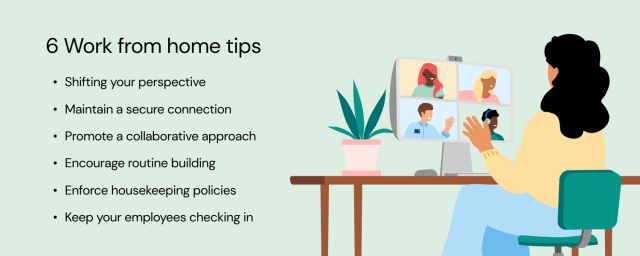Insights
Working from home: how to ensure your company’s doing it right

Insights

It’s the new normal, and everyone is doing it. That’s right, the work-from-home (WFH) movement is now part of the modern workforce and it’s here to stay. While a global pandemic influenced the shift to a remote and hybrid workforce, it remains a logical solution for many organizations to have their employees be able to work from home.
However, working from home isn’t always easy. Unexpected challenges can happen when you move your company out of an office structure. Here are a few tips for implementing a remote work program within your organization that will help you maintain business continuity and productivity.
By now, you’ve seen most of the business world shift to working remotely and adopt hybrid work policies. What was once considered a perk for senior staff has now become commonplace.
It’s in a company’s best interests to ensure they have the right systems in place to drive as much value as possible from this sudden shift in the workplace. So, what should companies be aware of when considering implementing a WFH policy?
The loss of face-to-face contact between employees and their employers can leave either end feeling disconnected. Enabling spontaneous communication is crucial to keeping employees engaged and employers informed. Staying in touch is an excellent opportunity to reinforce relationships, as well as to hold employees accountable for the work they’re doing.
As an employer, regularly checking in on employees will help show you care and are there for your staff You should encourage workers to reach out when they have questions or concerns. The transition from a physical to a digital workplace can be intimidating and disorienting for employers as well. Asking for feedback following online meetings will not only help staff feel valued for their input but will allow for a successful transition.
An increased emphasis on setting clear-cut goals for employees to meet and holding them accountable to these goals is necessary to keep your work pace flowing. This also helps avoid any confusion which may come after such a drastic move.
Keeping track of which tasks employees are completing on a day-to-day basis and effectively communicating these daily tasks to your employees is vital to managing a focused and productive remote workforce.
Virtual meetings can be difficult to direct. Kicking off these meetings with a clear agenda that’s shared with every participant can do wonders for keeping discussions on the right track.
Constructive communication is fundamental to a remote work program functioning at full capacity.
Implementing a WFH policy isn’t as simple as telling your employees they can work from home. A reliable business continuity plan requires access to the right software, a commitment from the company itself, and a culture which empowers employees to do their best work from the comfort of their homes.
You should verify whatever unified communications as a service (UCaaS) platform you’re using is secure. Employees will want to make sure their connection is also secure, especially prior to accessing sensitive data.
You’ll want to put the right safeguards in place to minimize potential data breaches and other cybersecurity risks. It’s a good idea to provide your team with specific directions on how to handle certain aspects of cybersecurity and provide access to some of the tools they’ll need to protect your company’s data. Here are some ideas for how to tighten your business’ security, leaving your team to safely work from their homes:
Protect remote users’ devices: It’s much safer if employees use company-issued computers. They should secure their home router, use strong passwords, set up two-factor authentication, install IT-requested updates regularly, check removable devices for viruses, and lock devices so others can’t access them. You and your staff can reduce infections from data-stealing malware by using security software. Practice good computer hygiene by uwith the latest versions of all apps along with installing new security patches immediately. System administrators should activate automatic updates or use a patch management tool rather than relying on employees to update apps.
Provide remote workers with a secure connection to your company’s network: You can ensure encryption for remote workers’ Internet traffic by using tech like a virtual private network (VPN). Your team should stick with using the company-sanctioned VPN client when required and avoid using public WiFi.
Practice good communication and data hygiene: Encourage your team to always backup their data, be wary of remote desktop tools, look out for phishing emails and sites, watch for WFH scams, ignore questionable files or links, check the validity of email addresses, delete emails asking for personal data, and report suspicious activity to IT.
To increase your company’s chances of having a smooth transition to WFH, it’s important to communicate your online security protocols to your employees and have IT team members available to help troubleshoot and answer questions.
One of the most essential aspects of a successful remote work program is allowing employees and employers to collaborate effectively. Whether this involves team messaging, video conferencing, or screen sharing — having the right tools for remote work is incredibly important for facilitating hassle-free group communication and is vital for maintaining productivity.
A unified communications service delivers a consistent user experience to employees no matter the location. To ensure employees can collaborate effectively, they need access to a common interface and tools for sharing information. Collaboration of remote work teams will suffer if they’re working on different application versions or if an operating system or browser doesn’t support it. The key benefit of the cloud-based platform is it routes all users to a common Internet-hosted server with access across any device, screen, and network connectivity environment.
UCaaS connects everyone in your company, allowing your team to communicate more efficiently and effectively from anywhere. If you’re looking for a solution to support your team’s communications, Sinch UCaaS is more than a phone system — it’s an easy-to-personalize solution which integrates mobility, video, and collaboration tools without the cost of maintaining expensive on-site equipment and resources.

Working from home can be fruitful for your staff. Instructing employees to keep regular working hours and encouraging them to stick to a schedule within their workdays is key to maintaining productivity and allowing quick communication whenever necessary.
It’s critical to have a clear remote work policy, where employees understand what they’re expected to do in a workday and when they need to be available for team meetings.
Teams can track progress using a shared project management app, having regularly scheduled meetings, or by instant messaging with a desktop or mobile client included in a UCaaS solution.
Wth such a drastic change to a WFH routine, Growing pains are going to happen . It’s important to establish a set of rules for remote communication — and to stick to them if you want to lessen the side chatter and the temptation to veer off-topic. If respected and enforced, these simple rules will allow for a virtual experience which is as pleasant and constructive as possible under the circumstances.
Reminding everyone their interactions should be respectful may be necessary in a hybrid work scenario, where informality rather than formality is often the norm.
Consider drafting basic communication policies to limit side chatter during group discussions. When communicating with each other, the goal should always be to communicate as clearly and concisely as possible to minimize confusion and fulfill the objective of the meeting. Remember, employers should get into the practice of checking in to ensure everyone has had a chance to speak without being missed or interrupted.
A unique challenge employers should be prepared for when implementing a WFH program is having young children and pets in the workplace. Encourage workers to set boundaries within the home when this is the case. For example, ask employees to create a “Do Not Disturb” sign to hang on the door of their workspace to prevent them from being interrupted during online meetings. Using the mute button when you’re not speaking is also helpful in avoiding a hungry dog from barking over another meeting attendee.
These simple housekeeping policies may seem minor at first, but they can make a big impact on the quality of your meetings, productivity, and more.
As an employer, maintaining a workplace which encourages friendliness, cooperation and support is even more important with the transition to digital platforms.
It’s crucial to encourage workers to check in, not just with you, but with one another as well. This will ensure everyone is on the same page and keep you aware of any potential or showstoppers before they stop the show.
Hybrid work is more than possible with the right tools and processes to support it. Online work and the tools making it possible have been rising in popularity for years. The pandemic simply accelerated this trend.
Organizations with these solutions in place will continue to remain productive as they embrace different forms of flexible work.
What is your company doing to stay productive in a distributed work environment? Do you have access to the right communications tools to ensure your business continuity? Sinch offers industry-leading UCaaS, cloud fax, and SIP trunking services your company can use to stay connected and productive regardless of where your team works.
Are you interested in learning more? Talk to an expert.